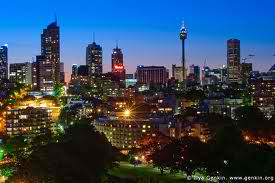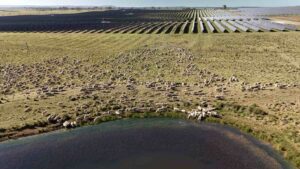The City of Sydney plans to build a network of gas burners, each of which would simultaneously provide power, heating and cooling to public and private buildings.
The City believes that this approach – known as trigeneration – would reduce the carbon emissions of connected buildings by 40 to 60 per cent.
Unfortunately, rolling out a trigeneration network would have the highly undesirable consequences of fostering coal-seam gas production – which has dire environmental side-effects – and reducing the amount of biogas available to chemical and industrial processes.
It would also be a missed opportunity to build a grid powered by wind and solar. We have already covered this in our earlier article at Renew Economy.
Talking biogas, using coal-seam gas
Building the trigeneration network would result in greater demand for gas in NSW. This is because it would displace grid electricity that is currently largely drawn from non-gas sources (ie coal).
The future of gas supply in NSW is clouded with doubt. As reported in the Sydney Morning Herald in April, the NSW state government has warned that ”Bass Strait and Cooper Basin gas supplies are dwindling at a time when the gas export industry is growing at an extraordinary rate.”
This means that, for the foreseeable future, the demand for extra gas will stimulate growth in the dirty, unconventional gas sector – shale gas in SA, and coal-seam gas in QLD and NSW.
This will reduce or even negate any hoped-for environmental benefits of the trigeneration plan. Coal-seam gas and shale gas have been linked to high rates of fugitive methane emissions in gasfields in the US and there are fears that the same problems may be occurring here.
When campaigners pointed out that the rollout of gas generation would support the development of the coal-seam gas industry, the City of Sydney’s response was confused.
At first, the City’s chief development officer of Energy and Climate Change, Allan Jones, said “trigeneration cannot run off coal-seam methane as this contains damaging trace elements which would destroy the trigeneration engines… the effect would be similar to filling up a petrol car with diesel fuel”.
Addressing this confusion about whether “gas is gas”, the Australian Energy Market Operator, in the 2011 GSOO Gas Statement, notes that:
“The major chemical constituent of both conventional and unconventional gas is methane. Although unprocessed gas from either source contains various minor components and contaminants, gas from conventional and unconventional sources can be mixed before or after processing to industry quality standards and used interchangeably in gas transmission and distribution networks.”
The Australian Energy Market Operator predicts that 84-85 per cent of the nation’s future gas will come from unconventional (read coal seam or shale gas) fields. Clearly, this gas is quite able to fuel trigeneration.
The live depiction of the gas market here shows a significant amount of gas flowing from Queensland, predominately Roma (CSG collection area) into Adelaide and Sydney via Moomba.
The City of Sydney obviously doesn’t want to be seen supporting coal seam gas. Its next position was to argue that renewable biogas could at some time in the future be substituted for the fossil gas currently in the network.
Consultant Jonathan Prendergast argued that the biogas age will arrive and the trigen system will be fine. But we have to ask: how many years would Cogent, Origin Energy’s subsidiary, contract existing conventional fossil gas supplies? Origin is the biggest name in CSG.
Denmark does not prove biogas is the way forward
Prendergast cited biogas developments in Denmark to support his case. But biogas is not the booming renewable sector there.
Denmark plans to source half its electricity from wind power by 2020. This means Denmark will have about 5000 wind turbines (the majority of which, similarly to Australia, will be onshore).
Denmark does not have an explicit biogas target but it does have a renewable heating target, which can include things like heat pumps (geothermal and reverse cycle airconditioning) as well as biomass and biogas for providing domestic, commercial and industrial heat. Of the biomass portion, solid biomass is a significantly greater contributor than biogas.
In 2001, Denmark’s biogas production was 3.6 petajoules; in 2011, it was 4.2 petajoules – a rise of about 16 per cent in a decade. The biggest power plant producing electricity from biogas is the Lemvig plant, built in 1992. Nothing bigger has been built in the 20 years since.
Lemvig produces the equivalent annual net electricity of just one Enercon E-126 wind turbine (rated capacity 7.5 megaWatt). The entire nation has less than 200 biogas plants, which produce the equivalent net electricity of 16 E-126 turbines, or roughly the same as Tasmania’s Woolnorth wind farm.
To supply enough gas for the City of Sydney’s projected trigeneration precinct would require four times as much biogas as Denmark produced in 2011. Remember, this is a sector Denmark has been developing for two decades.
Use biogas where it is needed
The 17PJ of gas that would be required annually would require a larger amount of biomass feedstock to convert to biogas, probably in the order of 25-30PJ primary energy.
CSIRO (Farine et al 2012) estimates of biomass availability include roughly 240-280PJ/year of what BZE might consider sustainably harvested biomass. The likely requirements of the City of Sydney would take up more than 10% of this limited resource, when the conversion factor to biogas is considered.
This would be competing against not just electricity demand in other centres but all other possible uses, including transport and industrial feedstocks, and biochar production to draw excess carbon out of the atmosphere.
Chemical and industrial processes that rely on gas as a feedstock are considerable. Australian Bureau of Agricultural and Resource Economics‘s figure for chemical processes in Australia is 115 PJ.
If we aim to clean up Sydney CBD buildings’ emissions, it makes no sense to do so at the cost of our ability to clean up other sectors of the economy.










